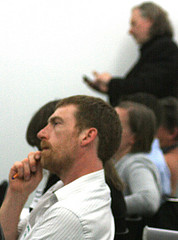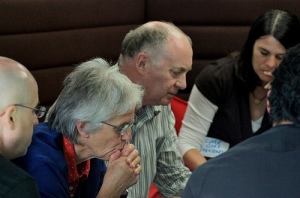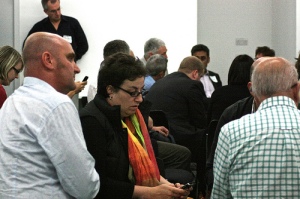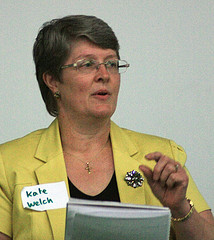On the evening of 1st November 2011, I did something extremely unusual for me: I went to a meeting about urban planning issues. It was the start of a community consultation process about the Ouseburn area in Newcastle upon Tyne.
The Ouseburn (also written as ‘Ouse Burn’) is a small river in a steep valley, and ‘the Ouseburn’ is commonly used to mean the entire valley, or even the whole area. Part of the valley, much of it formerly owned by Lord Armstrong, has been turned into public parks: Paddy Freeman’s Park, Jesmond Dene (‘dene’ means ‘steep, wooded valley’), Armstrong Park, Heaton Park. Then there is the interruption in the valley: City Stadium. The river was put into a culvert, and the valley was used as a rubbish tip. People who knew the area then can remember the smell and vast quantity of flies in the houses around it (many houses were demolished in late 20th century), and tell of smoke (or steam) rising from the ground for years after the tip had been covered over.
The City Council discovered that the land was too unstable to construct the buildings and stands for the planned stadium so it remains as a green amphitheatre with a rough running track and footpaths around the outside. The valley reappears at the southern end of City Stadium, and in grand style as the various bridges and viaducts are revealed. There are sheep and goats bleating, cockerels crowing, pigs oinking, sometimes the clatter of horses’ shoes on cobbles. In spring, the air is filled with birdsong and flurries of feathers as birds rush to gather food and push it into their offspring. A couple of people have told me that they have seen the jewelled flash of kingfishers fishing in the Ouseburn.
This is no rural idyll, however. This was Newcastle’s first modern industrial quarter, starting in the 1600s when it was outside the Town Walls. The valley’s proximity to the heart of Newcastle and the principal transport route of the Tyne made it ideal for developing industry. There was a market in the town for goods produced in Ouseburn, a population to provide labour, and goods could easily be exported from there to further afield.
Industry in the valley during the 1600s to 1900s included a leadworks, glassworks, blacksmithing, flax mill, potteries and a toffee factory. There is still a really interesting mix of people including motor vehicle engineers, architects, craftspeople and artists.
There is a small farm (the Ouseburn Farm) to educate and demonstrate farming and ecology; and the Stepney Bank Stables not only provide riding lessons but also unique personal development work to help people gain confidence and social skills (please look at their website to find out more about their extraordinary charitable work). The livestock and wildlife seems fairly unperturbed by loud rock music produced by some of the music-focused businesses also based in the valley.
At the event we attended, we were asked to write on a note a word that described Ouseburn – “the Ouseburn-ness of Ouseburn.” I wrote several but the one that I especially remember is “gritty.” Apart from the metaphorical grit, there is literally a lot of grit on paths and on the ground surfaces of derelict areas. There is also broken glass, burnt tyres, charred fencing, polystyrene packaging, bits of bicycle and all kinds of discarded things. There are certainly rats. I have seen some of them, and they always look remarkably plump.
I was not sure what to expect of the Community Design Vision Project launch, or what kind of people to expect to meet there. The Design Council and CABE has funded Northern Architecture to work with the Ouseburn Trust on this project. I had heard of it when Northern Architecture had asked me in a tweet if I were coming to it. Such a direct approach was good because it made it very clear that I could be involved. It came at a time when I had started to think that I could and should be involved more directly with my city’s environment in my spare time. Once before, I had expressed willingness to be involved with a council-led environment project but they never contacted me again, which had put me off trying to be involved with such things. This event encouraged me again.
The other community people there, as well as the facilitators, were really interesting and most people were friendly. After going round the activity tables, we chose a table to sit at and discuss issues in a little more depth. The facilitator for each table then summarised his or her table’s discussion for all. Strong themes that emerged from all was the sense of being custodians of the place; and the strong feeling that Ouseburn is our secret, almost a hidden valley.
What really fascinated me was the support for the street art and skateboarders. I had intended to speak up about the need to leave space for them, and had been prepared for people to think this was not a good idea, but there seemed to be a lot of agreement that the street art added a vibrancy to the area. Some of the businesses give permission for walls and metal shutters to be painted. I would like to see more space for them. I find the iconography and styles of the paintings fascinating, and clearly many others enjoy them too. There is an energy in the relatively ephemeral nature of these paintings, and the fact that their ephemerality is the result of a social process.
I was going to raise the question about the skateboarders too, but I was very pleased to hear another group talking about it. I wondered if the skateboarders who sneak into the ground that is due to be redeveloped realise that we notice and are sympathetic to their need for suitable space. Then I wondered if we can get them involved in this aspect of the civic space.
At one point, I remember suggesting that Ouseburn could take much more daring new architectural design. I am thinking of quite small buildings, in scale with most of the current buildings. Part of the valley is overlooked by part of the splendid, award-winning (and Listed) Byker Wall by Ralph Erskine. The most recently opened new office space in the valley is the intriging new Toffee Factory, a project in which the architects took a less traditional approach to conserving interesting built heritage.
The meeting seemed to conclude that we do not want to see the Ouseburn preserved in aspic, that we want some raw edges, creativity, energy. We also agreed that although we want to encourage businesses, we do not want to see it taken over by the big corporations. We agreed that there is a delicate balance to be maintained between order and chaos, preservation and development, creative businesses and gentrification.
The subsequent events should prove even more interesting.
Further reading
Ouseburn Trust http://www.ouseburntrust.org.uk/
Community Design Vision Project’s launch, Ouseburn Trust’s website.
Northern Architecture http://www.northernarchitecture.com/
The Design Council and CABE http://www.designcouncil.org.uk/









